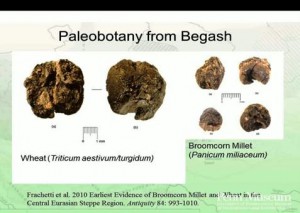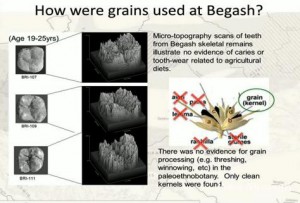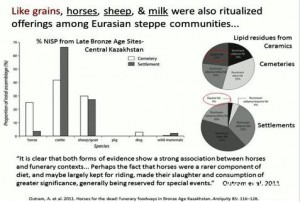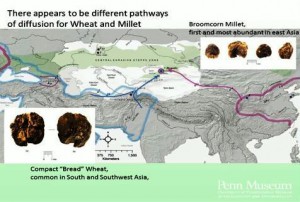- German donor examines food and security, notes “the fast loss of biodiversity”.
- Food carts are successful oases in at least one food “desert”.
- Yesterday’s Botany Photo of the Day was American cotton.
- Good news, everyone: “Hardcore farmers prefer lowkey rituals.” Obviously the memo didn’t reach the children of the corn.
- Photosynthesis and climate change: it’s complicated.
- Native Americans try to reclaim control of their foodways. And their waists.
- “…every district should have a community-controlled seed centre with a gene bank for traditional seeds.” Of course it should. “The local available seed diversity needs to be protected and conserved at any cost.” Of course it must.
- “Right now, all over the world, projects are underway to store seeds…“
- Dark earths not just in Amazon, Africa too.
- Presentation on IFAD project on cultivating wild aromatic etc. species for money in Morocco.
Nibbles: ITPGRFA, Hotspots, Adaptation, Agrobiodiversity, Potatoes and climate change, Cowpeas and drought, Apios, Tree planting, Fairtrade, Egyptian archaeobotany, Bolivian video
- All about the International Treaty on PGRFA.
- More, much more, on that climate change hotspots study.
- IDRC on climate change adaptation in Africa. Almost nothing on agricultural diversity as a coping mechanism.
- Unlike this.
- Or this, for that matter. Never knew the Basque country was such a hotbed of potato research.
- Or…oh forget it.
- What, in the name of all that is happy, is hopniss?
- Danone buys some goodwill.
- Fairtrade chocolate: this looks like it should be really important. Is it?
- So, you say you want to know what plant remains were found in the baskets in Tutankhamun’s tomb?
- Bolivian agricultural biodiversity, anyone?
Brainfood: Baby’s veggies, Chickpea and drought, Vine cactus breeding, Paleolithic rabbits, California protected areas, Wild pigeonpea, Pecorino classification, Milk composition, Phenotyping, Wild peas
- Vegetables by Stealth: an exploratory study investigating the introduction of vegetables in the weaning period. Sneaking them into the diet is the most common strategy used by mothers to introduce their kids to vegetables. Reeeeeally?
- Assessment of Iranian chickpea (Cicer arietinum L.) germplasms for drought tolerance. Four out of 150 local landraces showed promise. It really is a numbers game, isn’t it?
- In situ induction of chromosome doubling in vine cacti (Cactaceae). Potentially valuable autopolyploids were produced. Not that it was easy or anything.
- Who brought in the rabbits? Taphonomical analysis of Mousterian and Solutrean leporid accumulations from Gruta Do Caldeirão (Tomar, Portugal). People did, that’s who, but only during the later Upper Paleolithic. Before that it was mainly owls.
- Protected areas in climate space: What will the future bring? Nothing good. Both novel and disappearing climates are over-represented in current protected areas, at least in California.
- Progress in the utilization of Cajanus platycarpus (Benth.) Maesen in pigeonpea improvement. Baby steps.
- Classification of pecorino cheeses using electronic nose combined with artificial neural network and comparison with GC-MS analysis of volatile compounds. Wait, there are different kinds of pecorino?
- The need for country specific composition data on milk. Well, you’ve got me convinced.
- Rate-distortion tradeoff to optimize high-throughput phenotyping systems. Application to X-ray images of seeds. So, let me get this straight, basically, gauging the optimal trade-off between speed and accuracy in high-throughput phenotyping systems depends on what you’re measuring? Who writes these grant applications?
- Experimental growing of wild pea in Israel and its bearing on Near Eastern plant domestication. First pea growers were either very patient or very quick workers.
Nibbles: Cassava, Biopiracy, Neolithic, Potato history, Pollinator conservation
- The pros and cons of biofortified cassava rehearsed for the nth time.
- Scientists accused of biopiracy for the nth time.
- nth genetic study of ancient farmers. Men moved, in a nutshell, women not so much.
- Traditional healers: nth example of a group hard hit by climate change.
- In all above cases, n is a large positive integer.
- Potatoes responsible for about 25% of Old World population increase between 1700 and 1900. Nice maths.
- Learn how to conserve pollinators. If you’re in Rhode Island. But there is an online Pollinator Conservation Resource Center with lots of resources.
Using ancient grains to remap perceptions of Central Asia
The Silk Road Symposium held at the Penn Museum in March 2011 was clearly quite a get-together, judging by the personalities involved. Some of the presentations are on Youtube, including one by Dr Michael Frachetti on “Seeds for the Soul: East/West Diffusion of Domesticated Grains,” which has been picked up and discussed by Dienekes on his blog. It’s really worth listening to the whole talk, even at 45 minutes, but in case you don’t have the time, here are the main points.
 Dr Frachetti excavated at a place called Begash in Uzbekistan. This is a site which goes back to at least 2500 BC and was used by nomadic pastoralists for many centuries. The dig came up with the earliest evidence of wheat and broomcorn millet in Inner Asia, dating back to about 2200 BC. At left is what the seeds they found look like (click to enlarge).
Dr Frachetti excavated at a place called Begash in Uzbekistan. This is a site which goes back to at least 2500 BC and was used by nomadic pastoralists for many centuries. The dig came up with the earliest evidence of wheat and broomcorn millet in Inner Asia, dating back to about 2200 BC. At left is what the seeds they found look like (click to enlarge).
 But here’s the thing. There’s no evidence that the people living at Begash at the time actually ate these things. ((Now, I know that Central Asia does not necessarily mean the Silk Road, and things have changed since then anyway, but for an entertaining look at the food of the latter, check out the recent post at The Edible Schoolyard.)) Their teeth just don’t look like the teeth of people who have a lot of cereals in their diet. Basically, no cavities. And there was no evidence of processing either. So what was happening?
But here’s the thing. There’s no evidence that the people living at Begash at the time actually ate these things. ((Now, I know that Central Asia does not necessarily mean the Silk Road, and things have changed since then anyway, but for an entertaining look at the food of the latter, check out the recent post at The Edible Schoolyard.)) Their teeth just don’t look like the teeth of people who have a lot of cereals in their diet. Basically, no cavities. And there was no evidence of processing either. So what was happening?
 The seeds were recovered from a very particular context — a cremation burial. And only in that context. Along, incidentally, with horse remains. Both the cereals and horses were in fact ritual commodities, the excavators think. Not stuff to be consumed every day, but rather exotic commodities to be wheeled out on very special occasions to make an impression. As Dienekes points out, using wheat for funerary offerings goes on still.
The seeds were recovered from a very particular context — a cremation burial. And only in that context. Along, incidentally, with horse remains. Both the cereals and horses were in fact ritual commodities, the excavators think. Not stuff to be consumed every day, but rather exotic commodities to be wheeled out on very special occasions to make an impression. As Dienekes points out, using wheat for funerary offerings goes on still.
 Where did the cereals come from? To cut a long story short, the wheat from the west and the Panicum millet from the east. ((The Panicum miliaceum story is fascinating, with its pre-5000 BCE appearance of cultivated forms in the archaeological record in both China and around the Black Sea, but not in between. It is mentioned as an unsolved puzzle — independent domestication or long-distance contact? — by Prof. Colin Renfrew in his own talk, which refers to the genetic work of Dr Harriet Hunt.)) Which is the reason why Dr Frachetti thinks we need to remap our thinking about Central Asia. It’s not so much that the people who inhabited these regions were peripheral to the great Bronze Age civilizations, but rather (or, perhaps, also) that they were the link between them.
Where did the cereals come from? To cut a long story short, the wheat from the west and the Panicum millet from the east. ((The Panicum miliaceum story is fascinating, with its pre-5000 BCE appearance of cultivated forms in the archaeological record in both China and around the Black Sea, but not in between. It is mentioned as an unsolved puzzle — independent domestication or long-distance contact? — by Prof. Colin Renfrew in his own talk, which refers to the genetic work of Dr Harriet Hunt.)) Which is the reason why Dr Frachetti thinks we need to remap our thinking about Central Asia. It’s not so much that the people who inhabited these regions were peripheral to the great Bronze Age civilizations, but rather (or, perhaps, also) that they were the link between them.